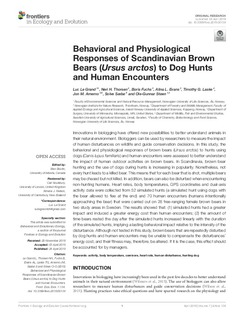| dc.description.abstract | Innovations in biologging have offered new possibilities to better understand animals in their natural environment. Biologgers can be used by researchers to measure the impact of human disturbances on wildlife and guide conservation decisions. In this study, the behavioral and physiological responses of brown bears (Ursus arctos) to hunts using dogs (Canis lupus familiaris) and human encounters were assessed to better understand the impact of human outdoor activities on brown bears. In Scandinavia, brown bear hunting and the use of dogs during hunts is increasing in popularity. Nonetheless, not every hunt leads to a killed bear. This means that for each bear that is shot, multiple bears may be chased but not killed. In addition, bears can also be disturbed when encountering non-hunting humans. Heart rates, body temperatures, GPS coordinates and dual-axis activity data were collected from 52 simulated hunts (a simulated hunt using dogs With the bear allowed to flee at the end) and 70 human encounters (humans intentionally approaching the bear) that were carried out on 28 free-ranging female brown bears in two study areas in Sweden. The results showed that: (1) simulated hunts had a greater impact and induced a greater energy cost than human encounters; (2) the amount of time bears rested the day after the simulated hunts increased linearly with the duration of the simulated hunts, implying a lasting behavioral impact relative to the intensity of the disturbance. Although not tested in this study, brown bears that are repeatedly disturbed by dog hunts and human encounters may be unable to compensate the disturbances’ energy cost, and their fitness may, therefore, be altered. If it is the case, this effect should be accounted for by managers. activity, body temperature, carnivore, heart rate, human disturbance, hunting dog | |
